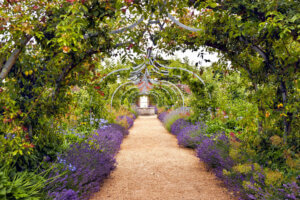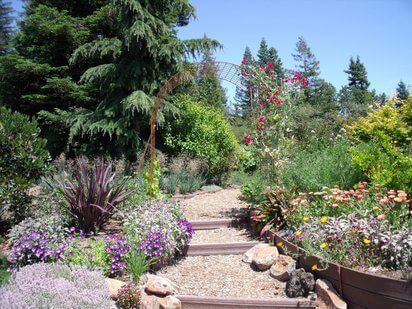A Mediterranean or An English Garden?

Which do you prefer? Let’s begin by saying these are two completely different styles. Both are beautiful, for sure. Continue reading to find out more!
Gardens, like homes, have different atmospheres and styles. It’s important to understand this while deciding on one type of garden or another, you mustn’t forget the type of landscape and architecture surrounding it.
English and Mediterranean gardens
Firstly, let’s look at the main features of these two types of gardens. This will inspire you. We’re looking forward to showing them to you!
The English garden

The layout is put together in such a way that it hardly shows human intervention. However, this is a space seeking to awaken sensations with a large number of plants and an authentic manifestation of colors.
Six fundamental characteristics of an English garden:
- Its purpose is to create a natural and wild look
- This type of garden has irregular lines and winding paths, also, there’s no defined visual center
- It contains random architectural structures such as sheds, greenhouses, pergolas, and arches
- A floral garden, with changing colors throughout the year represents this kind of garden
- This garden is usually divided by a wall or lattice to include a vegetable garden
- It incorporates British elements, such as picket fences and paths defined by small stones
Maintenance of an English garden
Even though the English garden gives the impression that everything happens randomly, in an improvised way, this is merely an appearance, since it also needs proper maintenance.
The jobs include planting different seasonal plants so there are always flowers, mowing the lawn, and maintaining the well-marked and defined paths or trails.
Roses with contrasting yellow and pale pink are a suitable option in this style of garden. Other varieties of flowers you can choose from are lilies, camellias, anemones, clematis, and some varieties of jasmine.
For structures such as pergolas or arches, we recommend using climbing plants such as wisteria. The walls will be covered in green. Ivy and Virginia creepers are also two options.
In open areas, you can plant trees such as cedars, silver maples, and magnolias. You’ll see how good they look in your English garden.
The Mediterranean garden

This garden is characterized by its freshness and is usually by the sea. It requires low maintenance since it’s based on native species.
Six fundamental features of a Mediterranean garden are:
- The terrain is uneven with a predominance of slopes and dips that multiply the design possibilities
- The vegetation is resistant to adverse weather conditions and water scarcity
- There are large areas of shade to put, for example, pergolas with furniture to shelter from the sun
- They have alternate lawns with gravel areas and paving is also often used
- It includes rock gardens (a composition of rocks and plants)
- There’s a significant presence of water through pools, ponds, and fountains, both in the garden and on paved patios
Flowers and bushes

Colors and aromas are the characteristic notes of this garden. There are different varieties of flowering plants, shrubs, and fruit trees, such as lemon trees.
Bottlebrushes with their flowers of mauve petals and silky silver pampas grass are two options to consider when designing this garden.
You can also grow plants from tropical and semi-tropical climates, such as the exotic bird of paradise or hibiscus. Another alternative is bougainvillea and as a compliment, you can also plant white jasmine.
In a Mediterranean garden, there’s no shortage of fragrant herbs that, in addition to being easy to maintain, flood the environment with aromas. Any species is suitable for cultivation: rosemary, thyme, lavender, or sage, they’re all good options.
The next step is to decide. Both the English garden and the Mediterranean garden are two lovely choices. Have fun designing!








